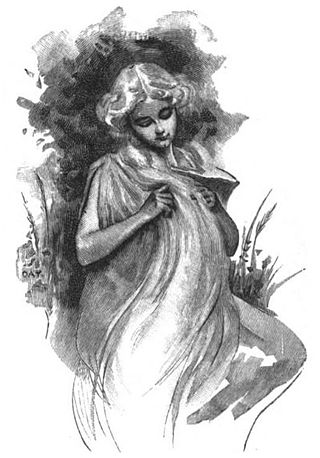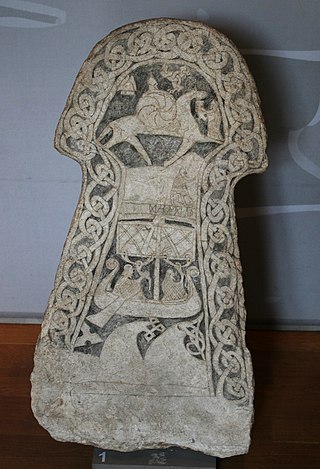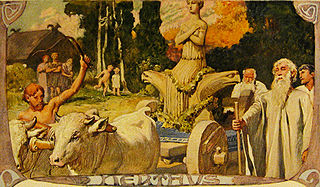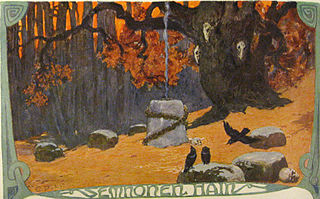Related Research Articles

In Norse mythology, Huginn and Muninn are a pair of ravens that serve under the god Odin and fly all over the world, Midgard, and bring information to the god Odin. Huginn and Muninn are attested in the Poetic Edda, compiled in the 13th century from earlier traditional sources: the Prose Edda and Heimskringla; in the Third Grammatical Treatise, compiled in the 13th century by Óláfr Þórðarson; and in the poetry of skalds. The names of the ravens are sometimes anglicized as Hugin and Munin, the same spelling as used in modern Danish, Norwegian, and Swedish.

In Norse mythology, Sif is a golden-haired goddess associated with earth. Sif is attested in the Poetic Edda, compiled in the 13th century from earlier traditional sources, and the Prose Edda, written in the 13th century by Snorri Sturluson, and in the poetry of skalds. In both the Poetic Edda and the Prose Edda, she is known for her golden hair and is married to the thunder god Thor.

In Norse mythology, a valkyrie is one of a host of female figures who guide souls of the dead to the god Odin's hall Valhalla. There, the deceased warriors become einherjar. When the einherjar are not preparing for the cataclysmic events of Ragnarök, the valkyries bear them mead. Valkyries also appear as lovers of heroes and other mortals, where they are sometimes described as the daughters of royalty, sometimes accompanied by ravens and sometimes connected to swans or horses.

Þrúðr, sometimes anglicized as Thrúd or Thrud, is a daughter of the major god Thor and the goddess Sif in Norse mythology. Þrúðr is also the name of one of the valkyries who serve ale to the einherjar in Valhalla. The two may or may not be the same figure.
In Norse mythology, Sæhrímnir is the creature killed and eaten every night by the Æsir and einherjar. The cook of the gods, Andhrímnir, is responsible for the slaughter of Sæhrímnir and its preparation in the cauldron Eldhrímnir. After Sæhrímnir is eaten, the beast is brought back to life again to provide sustenance for the following day. Sæhrímnir is attested in the Poetic Edda, compiled in the 13th century from earlier traditional material, and the Prose Edda, written in the 13th century by Snorri Sturluson.

In Norse mythology, Auðumbla is a primeval cow. The primordial frost jötunn Ymir fed upon her milk, and over the course of three days she licked away the salty rime rocks and revealed Búri, grandfather of the gods and brothers Odin, Vili and Vé. The creature is attested solely in the Prose Edda, composed in the 13th century by Icelander Snorri Sturluson. Scholars identify her as stemming from a very early stratum of Germanic mythology, and ultimately belonging to larger complex of primordial bovines or cow-associated goddesses.

In Norse mythology, the einherjar are those who have died in battle and are brought to Valhalla by valkyries. In Valhalla, the einherjar eat their fill of the nightly resurrecting beast Sæhrímnir, and valkyries bring them mead from the udder of the goat Heiðrún. The einherjar prepare daily for the events of Ragnarök, when they will advance for an immense battle at the field of Vígríðr.

In Norse mythology, Fólkvangr is a meadow or field ruled over by the goddess Freyja where half of those that die in combat go upon death, whilst the other half go to the god Odin in Valhalla. Others were also brought to Fólkvangr after their death; Egils Saga, for example, has a world-weary female character declare that she will never taste food again until she dines with Freyja. Fólkvangr is attested in the Poetic Edda, compiled in the 13th century from earlier traditional sources, and the Prose Edda, written in the 13th century by Snorri Sturluson. According to the Prose Edda, within Fólkvangr is Freyja's hall Sessrúmnir. Scholarly theories have been proposed about the implications of the location.

In Norse mythology, Óðr or Óð, sometimes anglicized as Odr or Od, is a figure associated with the major goddess Freyja. The Prose Edda and Heimskringla, written in the 13th century by Snorri Sturluson, both describe Óðr as Freyja's husband and father of her daughter Hnoss. Heimskringla adds that the couple produced another daughter, Gersemi. A number of theories have been proposed about Óðr, generally that he is a hypostasis of the deity Odin due to their similarities.

Máni is the Moon personified in Germanic mythology. Máni, personified, is attested in the Poetic Edda, compiled in the 13th century from earlier traditional sources, and the Prose Edda, written in the 13th century by Snorri Sturluson. Both sources state that he is the brother of the personified sun, Sól, and the son of Mundilfari, while the Prose Edda adds that he is followed by the children Hjúki and Bil through the heavens. As a proper noun, Máni appears throughout Old Norse literature. Scholars have proposed theories about Máni's potential connection to the Northern European notion of the Man in the Moon, and a potentially otherwise unattested story regarding Máni through skaldic kennings.

In Germanic paganism, Nerthus is a goddess associated with a ceremonial wagon procession. Nerthus is attested by first century A.D. Roman historian Tacitus in his ethnographic work Germania as a "Mother Earth".

According to Tacitus's Germania, Tuisto is the legendary divine ancestor of the Germanic peoples. The figure remains the subject of some scholarly discussion, largely focused upon etymological connections and comparisons to figures in later Germanic mythology.

Germanic paganism or Germanic religion refers to the traditional, culturally significant religion of the Germanic peoples. With a chronological range of at least one thousand years in an area covering Scandinavia, the British Isles, modern Germany, the Netherlands, and at times other parts of Europe, the beliefs and practices of Germanic paganism varied. Scholars typically assume some degree of continuity between Roman-era beliefs and those found in Norse paganism, as well as between Germanic religion and reconstructed Indo-European religion and post-conversion folklore, though the precise degree and details of this continuity are subjects of debate. Germanic religion was influenced by neighboring cultures, including that of the Celts, the Romans, and, later, by the Christian religion. Very few sources exist that were written by pagan adherents themselves; instead, most were written by outsiders and can thus present problems for reconstructing authentic Germanic beliefs and practices.

Sól or Sunna is the Sun personified in Germanic mythology. One of the two Old High German Merseburg Incantations, written in the 9th or 10th century CE, attests that Sunna is the sister of Sinthgunt. In Norse mythology, Sól is attested in the Poetic Edda, compiled in the 13th century from earlier traditional sources, and the Prose Edda, written in the 13th century by Snorri Sturluson.
In Tacitus' work Germania from the year 98, regnator omnium deus was a deity worshipped by the Semnones tribe in a sacred grove. Comparisons have been made between this reference and the poem Helgakviða Hundingsbana II, recorded in the 13th century from earlier traditional sources.

A grove of Fetters is mentioned in the Eddic poem "Helgakviða Hundingsbana II":

In Germanic paganism, a vé or wēoh is a type of shrine, sacred enclosure or other place with religious significance. The term appears in skaldic poetry and in place names in Scandinavia, often in connection with an Old Norse deity or a geographic feature.

Norse, Nordic, or Scandinavian mythology, is the body of myths belonging to the North Germanic peoples, stemming from Old Norse religion and continuing after the Christianization of Scandinavia as the Nordic folklore of the modern period. The northernmost extension of Germanic mythology and stemming from Proto-Germanic folklore, Norse mythology consists of tales of various deities, beings, and heroes derived from numerous sources from both before and after the pagan period, including medieval manuscripts, archaeological representations, and folk tradition. The source texts mention numerous gods such as the thunder-god Thor, the raven-flanked god Odin, the goddess Freyja, and numerous other deities.

Ganna was a Germanic seeress, of the Semnoni tribe, who succeeded the seeress Veleda as the leader of a Germanic alliance in rebellion against the Roman Empire. She went together with her king Masyus as envoys to Rome to discuss with Roman emperor Domitian himself, and was received with honours, after which she returned home. She is only mentioned by name in the works of Cassius Dio, but she also appears to have provided posterity with select information about the religious practices and the mythology of the early Germanic tribes, through the contemporary Roman historian Tacitus who wrote them down in Germania. Her name may be a reference to her priestly insignia, the wand, or to her spiritual abilities, and she probably taught her craft to Waluburg who would serve as a seeress in Roman Egypt at the First Cataract of the Nile.
References
- Lindow, John (2001). Norse Mythology: A Guide to the Gods, Heroes, Rituals, and Beliefs . Oxford University Press. ISBN 0-19-515382-0
- Orchard, Andy (1997). Dictionary of Norse Myth and Legend. Cassell. ISBN 0-304-34520-2
- Simek, Rudolf (2007) translated by Angela Hall. Dictionary of Northern Mythology. D.S. Brewer ISBN 0-85991-513-1